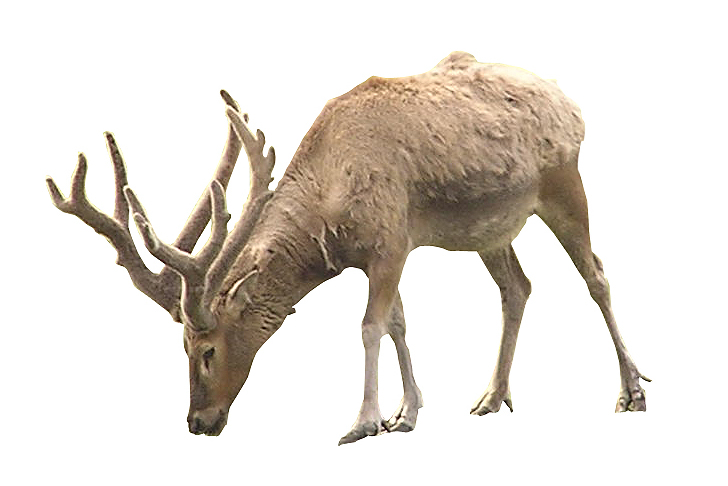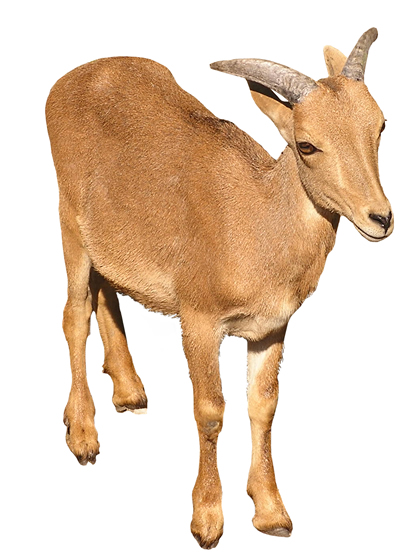Ever wonder what the difference is between antlers and horns? Many people automatically assume they are the same, but unfortunately nature is a bit more complicated than this. While antlers and horns may appear similar to the naked eye, they are two completely different formations in nature with their own unique features and characteristics. Let’s take a closer look at some of the differences between antlers and horns…
Antlers

Antlers are branching dead bones which grow directly out of the skull, typically becoming larger and more complex each passing year. All species of male deer (cervids) produce antlers annually and shed them annually between late winter to early spring when the mating season is over. However, in caribou, both the females (cow) and males (bull) grow them so they may use them to forage food in the snow. Typically, male caribou grow larger and more complex antlers than their female counterpart.
When the growth cycle of antlers begins, they are small and covered in a velvet-like substance that feeds blood and nutrients to stimulate the growth process. Scientists believe the overproduction of testicular and pituitary hormones fuels the antlers’ growth. The sunlight hitting the antlers also encourages them to grow faster and fuller. Once the growth is complete, the velvet with either fall off naturally or the deer will rub them off on trees and bushes. Fully developed antlers will remain on the deer until they are shed after the mating season.
The velvet-like substance covering new antlers is thought to provide numerous health benefits when consumed. It’s even considered a traditional Chinese remedy that’s been used for 2,000 years. You can usually find sprays and supplements containing antler velvet extract at most major nutrition stores. Check the link previously mentioned for more details on this rather unusual supplement.
Some of the many animals that grow antlers include:
- Deer
- Elk
- Moose
- Caribou
- Gazelle
- Antelope
Antlers are known as one of the fastest-growing natural formations in the animal kingdom. In fact, you might be surprised to hear that antlers can grow up to 1 inch per day! Of course, this growth slows back down once they are fully developed, but the velvet-covering allows for rapid growth in a short period of time. Because of their ability to grow so large in such a short amount of time, scientists are considering the possibility of using antlers as a medicine to treat cancer and other life-threatening conditions.

Horns
Horns are pointy projections of skin with a protective layer of keratin (fingernail-like substance) and other proteins surrounding the living bone underneath. Contrary to what some people may believe, horns aren’t attached to the skull and grow from their own center of origin. Typically found in ruminants, horns are often used to defend against predators, as well as show their dominance in the animal kingdom. In terms of strength, horns are more durable and all-around “tougher” than most antlers. If you cut into an antler and a horn, you will notice the horn is more solid inside.
Unlike antlers, horns are never shed and will continue to grow throughout the life of the animal. With that said, horns typically don’t branch and spider out in the same way that antlers do. The exact size and shape of antlers vary from animal to animal, but they never branch out like antlers do. Instead, they grow out in single points that may or may not curve into a spiral later on.
Another notable difference between the two is that both males and females grow horns, while only males grow antlers (with the exception of caribou of course).
Some of the animals that grow horns include:
- Bison
- Goats
- Rhinoceros
- Giraffes
- Muskox
- Wildebeest
Similarities of Antlers and Horns
As you can see, there are plenty of differences between antlers and horns. However, there are also some similarities that shouldn’t go unnoticed. For starters, both antlers and horns are used as a defensive mechanism to ward off predators. If a predator threatens the life of an antler- or horn-wielding animal, it will use these tough formations to fight the predator off. Rhinoceros are known for their ability to charge with their pointy horn first at speeds of 30 mph! Standing in front of such a powerful animal with a sharp horn on their head isn’t somewhere most predators want to be.
To the untrained eye, it’s oftentimes difficult to tell the difference between antlers and horns based on their appearance alone. They both originate from the head of the animal and continue growing outwards. As previously stated, however, antlers are shed annually while horns remain. Hopefully, this will give you a better understanding of the differences between these formations.
References:
http://www.nps.gov/yell/forkids/ahdiff.htm
http://animaldiversity.ummz.umich.edu/collections/mammal_anatomy/horns_and_antlers/
